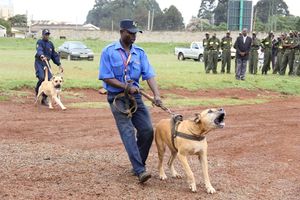Nairobi, Nakuru and six other counties register cases of rabies

Cases of rabies have been reported around the country. Without appropriate intervention to prevent the development of a clinical disease, rabies is 100 per cent fatal.
What you need to know:
- Rabies is caused by a virus that is nearly always transmitted to humans through bites and scratches from rabid animals.
- Without appropriate intervention to prevent the development of a clinical disease, rabies is 100 per cent fatal.
- Rabies is responsible for about 60,000 human deaths annually, mostly in developing countries.
- In Kenya, an estimated 2,000 people die annually of rabies due to bites from rabid dogs.
Eight counties have reported cases of rabies, with the highest percentage in Nairobi, a statement from the Kenya Small and Companion Animal Veterinary Association said.
The capital city leads, followed by Nakuru, Kwale, Kilifi, Wajir, Narok and Isiolo. A child also recently succumbed to rabies complications in Siaya after being bitten by a dog.
In Nairobi, cases have been reported in Oloolua, Karen, Runda and Dagoretti, while in Nakuru, they were reported in the Keragita area of Naivasha and Kambi ya Moto Nakuru city.
In Narok, several clinical cases were reported of dog bites in the Mara North Conservancy, Enaretoi, by local veterinary scouts. In Kwale, the cases were reported in Ukunda and Diani, Kilifi and Wajir.
In Isiolo, the cases were reported in Rumuruti, at camp Borana, while in Uasin Gishu, a nurse died after a bite from a suspected rabid dog, with two others receiving treatment.
In Siaya, a six-year-old boy succumbed to rabies complications after a dog bite in Sakwa village.
Rabies is caused by a virus that is nearly always transmitted to humans through bites and scratches from rabid animals. Without appropriate intervention to prevent the development of a clinical disease, rabies is 100 per cent fatal.
Rabies is responsible for about 60,000 human deaths annually, mostly in developing countries. In Kenya, an estimated 2,000 people die annually of rabies due to bites from rabid dogs. Africa accounts for 36 per cent of the 59,000 rabies deaths in humans annually.
But the Ministry of Health did not comment on the outbreak by the time this story was published.
Rabies has had an effective vaccine for more than a century, though people continue to die from the disease.
Rabies is also considered a neglected tropical disease. Typically, these diseases are not common at health facilities, so they are not the first healthcare workers think about when a patient seeks health services. Yet appropriate and immediate treatment is critical for saving lives from rabies.
Besides rabies, dogs can spread a range of other disease-causing organisms, including salmonella. There is also Toxocara canis, a parasite that can cause blindness in humans.
To protect dogs from diseases, dog owners should keep up with vaccination routines. With vaccination, one can prevent diseases like rabies, worms, bordetella, Lyme disease, parvovirus, leptospirosis and distemper.
Lack of life-saving vaccines at primary health centres is a daily stark reminder of the virulent nature of this neglected disease, said Mumbua Mutunga, a rabies researcher at the University of Nairobi’s Institute of Tropical and Infectious Diseases and the Kenya Medical Research Institute.
After a dog bite, it is a race against time to prevent the virus from travelling from the bite wound to the brain of the patient, a stage of the disease that has no known cure, and death follows, with the most horrifying symptoms.
Dog bite victims should immediately wash the wound with clean running water for at least 15 minutes. A visit to a health facility is highly recommended to receive the full dose of the recommended five post-exposure vaccines.
From the first day of the dog bite, the anti-rabies injections are normally given on the first, third, seventh, 14th and 28th day after exposure.
Unfortunately, rabies is a neglected zoonotic tropical disease whose burden and risk disproportionately affect poor rural communities.
A majority of rabies deaths are in children because they are more likely to play with dogs, and, when bitten, tend not to report to their parents for action.
In 2014, Kenya adopted a strategic plan for eliminating human rabies, in line with the global target of eliminating dog-mediated human rabies by 2030.
Mass dog vaccinations covering 70 per cent of the dog population are a cost-effective way to break dog-to-dog rabies transmission, in addition to human inoculation.
Counties and national governments should enforce laws and allocate resources for a multidisciplinary and holistic approach to the war on rabies. Rabies programmes should also have specific and measurable outcomes for tracking progress and providing evidence for rabies elimination.
But poor knowledge of disease transmission and prevention are the main challenge, said Veronicah Mbaire Chuchu, veterinarian and epidemiologist at Washington State University.
“Communities need to be educated on rabies and capacity enhanced for health workers with regard to rabies exposure assessment, diagnosis, administration and judicious use of the rabies vaccines,” she said.
Veterinarians need to tighten surveillance, risk assessment and reporting compliance to make data available.
A recent study showed that many healthcare workers rarely suspect rabies among bite patients, and were not fully informed of the latest World Health Organization (WHO) recommendations on treating patients with dog bites.
The WHO recommends that the rabies vaccine be given under the skin as an effective and dose-saving route compared with injecting the vaccine into muscles, which is equally effective but requires five volumes more of the vaccine.
“By adopting this dose-saving route, the healthcare system can serve up to five times more bite patients for the same vaccine amount that treats one patient," Ms Chuchu said.





